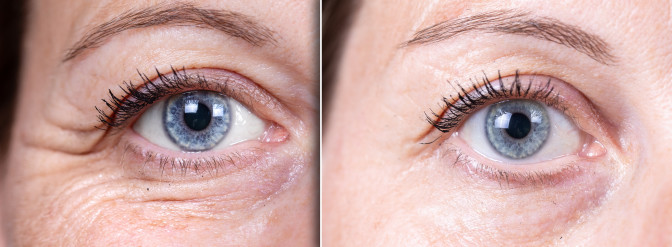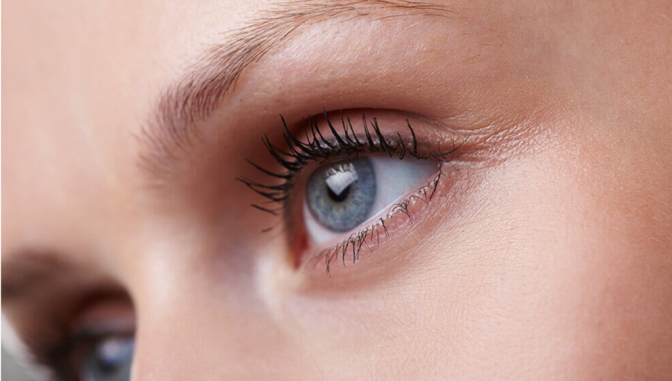Cosmetic Eyelid Surgery in Detroit, MI
Detroit, MI Eyelid Surgery Centers
Do you feel that you look “tired” and older than you are? Often, drooping and baggy eyelids are the cause. Today, many people have eyelid surgery to improve their looks and vision. This procedure is called Blepharoplasty. The shape and tone of your eyelids should give you a look of vitality and youthfulness. If they don’t, perhaps you should consider eyelid surgery. Schedule a consultation with the Detroit, MI oculoplastic surgeons of Eye Clinics of Michigan to see if cosmetic eyelid surgery is right for you.
Improve Your Appearance & Vision!
The eyes are the windows to the soul, but also one of the first areas to show signs of aging. Small wrinkles, droopy lids, excess skin, and bags under the eyes can make one appear tired or older than our age. Often, as the skin droops, our vision is even affected. Excess skin on the eyelids also often makes one feel tired at the end of the day. These changes often appear as early as the late 20’s.
Blepharoplasty (eyelid rejuvenation surgery) can turn back these signs of aging and make your eyes appear brighter and refreshed. By removing excess skin and fatty deposits, your eyelid is restored to a more youthful appearance. In addition, if your field of vision is being affected, you may see better following a blepharoplasty procedure.

Why Do Eyelids Become Baggy?
Sun damage, smoking, stretching from swelling or obesity, and the wear and tear from blinking and rubbing all contribute to a gradual deterioration in the eyelid’s tissues and their support. By far, however, the most important variable is one’s heredity expressed over time.
Functional Eyelid Surgery
If the eyelids begin sagging into the field of vision, a functional blepharoplasty may be required. The procedure may be covered by medical insurance if it is deemed medically necessary. A determination of how much vision is affected is done by checking the peripheral visual field with an instrument called the Humphrey Visual Field (VF) Analyzer.
Eyelid Surgery Options at Eye Clinics of Michigan
At Eye Clinics of Michigan in Detroit, MI, we are fortunate to have doctors who specialize in cosmetic and reconstructive surgery of the eyelids. Our doctors perform both cosmetic eyelid surgery for patients interested in a more youthful appearance and reconstructive eyelid surgery for patients with medical problems that affect their eyes such as thyroid eye disease. Our doctors can restore a more youthful appearance to your eyes by performing an upper and/or lower blepharoplasty procedure.
Upper eyelid surgery can address:
A lowered or overly-full fold on the upper lid of the eyes
Droopy, saggy excess skin above the eyes (ptosis)
Puffiness caused by fat deposits on the upper lids
Lower eyelid surgery can address:
Loose, excess skin that droops or sags below the eyes
Fine wrinkles below the eyes
Under-eye puffiness
Insurance does not generally cover lower eyelid blepharoplasty. Upper eyelid blepharoplasty may be covered in cases where your ophthalmologist determines the upper eyelid impairs vision or the function of the eye.
Eyelid Surgery Frequently Asked Questions
Since every pair of eyes is unique, operating times will vary with the extent of changes and scope of the operation. As a general guideline, performing upper or lower blepharoplasty alone takes about 45-60 minutes, while having them both performed together takes about 90 minutes.
Blepharoplasty is routinely performed under local anesthesia with oral sedation. Most patients report little or no memory of the procedure. Compared to general anesthesia, local anesthesia is associated with less bleeding, increased safety, enhanced precision, and faster recovery.
A realistic expectation is that most patients will achieve about a 75-90% improvement after upper blepharoplasty and a 60-80% improvement after lower blepharoplasty. Some slight asymmetry is the rule rather than the exception. With Asian double eyelid surgery, requested crease shapes and heights can be approximated but not guaranteed.
Blepharoplasty lasts a very long time. In the majority of patients, cosmetic eyelid surgery is performed only once.
The majority of patients report mild aching or burning, which is usually well controlled with Tylenol and cold compresses.
Most patients experience moderate discoloration that is gone within about ten days. Swelling peaks in the morning after surgery. While it mostly resolves over the next two weeks, a small amount may persist for several months or more.
In upper blepharoplasty, the incision is hidden in the crease. In lower blepharoplasty, the incision is placed along the back surface of the eyelid and/or just below the lashes. While full thinning and fading of any scar on the body can take a long time, keloids on the eyelids are rare.
While most normal tasks can be resumed within two days, too much activity during the first week will increase swelling. Strenuous activities should be avoided for two weeks or more. Most people prefer to lay low for several weeks.
While cost is obviously important, the quality of your care and outcome are most crucial. To learn more about blepharoplasty costs contact your Eye Clinics of Michigan office for an appointment.
Since eyelid skin is thinner than that on the rest of the face, the eyes are usually the first facial component to demonstrate a noticeable age-related loss of attractiveness. A person who is physically and psychologically healthy is ready to consider blepharoplasty whenever an improvement is desired.
Yes. Cosmetic surgery for men has become increasingly popular. Men can also benefit from a more relaxed, youthful and refreshed look.
No. Most semicircular rims of depression are the result of a relative deficiency of bone along the upper cheek with secondary sagging of the cheek’s fat pockets and muscles. Since the indentation (often called a “tear trough”) is not caused by an eyelid or orbital deficit, blepharoplasty does not correct it. Injection with a commercial filler is the most common treatment.
Eyelid hollowness is not the same thing as cheek hollowness, a tear trough, or dark circles, all of which are much more common conditions. If the lids themselves have become hollowed due to insufficient fat volume following overdone blepharoplasty or aging changes, they can sometimes be re-inflated by grafting fat into the socket around the eye.
Yes, but not drastically. Conservatism is key.
Oculoplastic surgeons are ophthalmologists (eye doctors) who have specialized in eyelid and facial plastic surgery. Oculoplastic surgeons are trained to do many different types of eyelid and facial surgery, ranging from simple eyelid malposition to more complex reconstruction involving the eyelids and surrounding forehead, temporal, and cheek areas. They understand the delicate anatomy and function of the eyelids and their surrounding structures. As well as the eyelids, they specialize in the lacrimal (tear) system, the orbit (bone cavity around the eye), adjacent periocular (around the eyes) and facial structures, and the forehead and cheeks. Oculoplastic surgeons are also known as ophthalmic plastic and reconstructive surgeons and oculo-facial surgeons.
Oculoplastic surgeons assess the surface health of the eyes and function of the eyelids prior to eyelid plastic surgery. As dedicated eyelid plastic surgeons, an oculoplastic surgeon routinely does surgeries in these areas, and recognizes potential problems. Oculoplastic surgeons are trained to manage the complications of eyelid and facial plastic surgery which can involve the eye itself.
Brownstown, MI Eye Care Center
The expert Detroit area eye doctors of Eye Clinics of Michigan have a convenient location in Brownstown, MI, on Allen Road. Visit our location page to see office hours, provider information, and more.
Wayne, MI Eye Care Center
The expert Detroit area eye doctors of Eye Clinics of Michigan have a convenient location in Wayne, MI, at the corner of Venoy Road and Forest Street. Visit our location page to see office hours, provider information, and more.

Schedule Your Cosmetic Eye Service Consultation Today
Thinking about getting cosmetic eyelid surgery? Book a consultation with the highly trained and trusted cosmetic eyelid surgeons of Eye Clinics of Michigan in Detroit, Michigan.
We’ll work with you to determine the best course of treatment for your needs.

 734-479-5580
734-479-5580